
Vietnamese textile and garment companies should focus more on developing their supply chain to enable them to capitalise on opportunities arising from free trade agreements, a panel discussion heard in HCM City this week. — Photo sggp.org.vn
Vietnamese textile and garment companies should focus more on developing their supply chain to enable them to capitalise on opportunities arising from free trade agreements, a panel discussion heard in HCM City this week.
Many foreign investors have been attracted to Việt Nam, especially after the recent signing of free trade agreements, including the EU-Viet Nam FTA, Pham Xuan Hong, chairman of the HCM City Association of Garment Textile Embroidery and Knitting, said.
The delegates agreed that FTAs bring opportunities but also challenges and risks for Vietnamese companies.
Oliver Massmann, general director of Duane Morris LLC and chairman of legal sector committee of the European Chamber of Commerce in Việt Nam, said the so-called fabric-forward rule of origin under the EU-Việt Nam FTA is a challenge for Vietnamese garment and textile companies.
Viet Nam depends on imported raw materials from China, Korea and Taiwan, and the sector does not create much value addition in the supply chain since it merely does low value-added work such as cut-make-trim services to transform fabric into garments to export, he said.
“A domestic supply chain must be established.”
Yarn production must now go together with weaving and dyeing, but environmental protection must be ensured, he said.
The FTAs would result in more foreign investment in Viet Nam in untapped parts of the value chain, and local companies would benefit from the expertise of foreign experts, he said.
Hong said: “Thus far our garment and textile sector has just been doing outsourcing. We were competing through low labour costs, but this is no longer an advantage. We must create new momentum to compete.”
Having reliable raw material sources at home and investment in technology would help create value for the sector, he said.
“Whether we have the TPP or not, the sector will develop as it has for many years.”
The EU, the second largest export market for Vietnamese garments and textiles, offers great opportunities for Vietnamese firms to boost exports, he said.
Enterprises in the sector have mapped out measures hoping to enjoy better growth next year and in the years to come, he said.
Goh Wee Hong, senior vice president of TUV SUD ASEAN's product services, said the Vietnamese food and garment industries have depended long enough on cheap labour and low costs, and “we need to invest in innovation, quality and food safety.”
Sathish Kumar Somuraj, general director of TUV SUD Vietnam, said: “Viet Nam has increased its business opportunities through FTAs with certain main global markets, especially the EU, US, Japan, Korea, and ASEAN. These agreements will not only bring global market access to Vietnamese businesses, it also means Vietnamese manufacturers are expected to comply with more stringent quality and safety regulations.”
TUV SUD and AGTEK have joined hands to help local manufacturers access global markets by offering training and other activities to provide them with an updated and more in-depth understanding of the stringent international quality and safety standards.
The panel discussion, titled “How Will Free Trade Agreements Affect Commodity Business Landscape in Viet Nam?”, was among events held to celebrate TUV SUD’s 150th anniversary.
The company is one of the world’s leading service providers in testing, inspection, audit and certification.
In future it would partner with local companies, especially in the garment textile and food-related industries, to help them gain confidence in their product quality so that they can maximise the potential benefits offered by FTAs, Somuraj said.
Hong said Viet Nam’s garment and textile exports are expected to increase by only 5.5 per cent this year to US$28.5 billion. — VNS